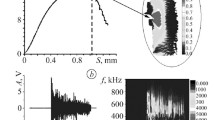Abstract
In this paper, we introduce the two-dimensional continuous wavelet transform for the automated strain analysis of the moiré interference fringe pattern. The Fourier transform method has been widely used for automated analysis of an optical interference fringe pattern. However, this method is hardly applicable to the analysis of the fringe pattern, which includes large displacement range or discontinuities. We show the advantages of the wavelet transform method by applying it to experimental results on composite laminates.
Similar content being viewed by others
References
McKelvie, J., andPerry, K.E., “Moiré Interferometry as a Detailed Validator for Computational Modeling of Composites,”Compos. Struct.,42,299–305 (1998).
Perry, K.E. Jr, “Delamination of Composite Materials Using Phase-shifting Interferometry,”Opt. Lasers Eng.,24,467–483 (1996).
Morimoto, Y., Gascoigne, H.E., andPost, D., “Carrier Pattern Analysis of Moiré Interferometry Using the Fourier Transform Moiré Method,”Opt. Eng.,33,2646–2653 (1994).
De Nicola, S., andFerraro, P., “Fourier-transform Calibration Method for Phase Retrieval of Carrier-coded Fringe Pattern,”Opt. Commun.,151,217–221 (1998).
Chui, C.K., “An Introduction to Wavelets,”Boston:Academic Press (1992).
Morimoto, Y., and Imamoto, Y., “Application of Wavelet Transform to Displacement and Strain Measurement by Grid Method,” Proc. SEM Spring Conf. on Experimental Mechanics, 898–903 (1995).
Watkins, L.R., Tan, S.M., andBarnes, T.H., “Determination of Interferometer Phase Distributions by Use of Wavelets,”Opt. Lett.,24,905–907 (1999).
Post, D., Han, B., andIfju, P., “High Sensitivity Moiré,”Berlin:Springer-Verlag (1994).
Antoine, J.-P., andMurenzi, R., “Two-dimensional Directional Wavelets and the Scale-Angle Representation,”Signal Process.,52,259–281 (1996).
Unser, M., “Fast Gabor-like Windowed Fourier and Continuous Wavelet Transforms,”IEEE Signal Process. Lett.,42,3519–3523 (1994).
Kadono, H., Takei, H., andToyooka, S., “A Noise-immune Method of Phase Unwrapping in Speckle Interferometry,”Opt. Lasers Eng.,26,151–164 (1997).
Ghiglia, D.C., Mastin, G.A., andRomero, L.A., “Cellular-automata Method for Phase Unwrapping,”J. Opt. Soc. Am. A 4,267–280 (1987).
Wang, B., et al., “Phase Unwrapping by Blocks,”Measurement,25,285–290 (1999).
Chang, H.Y., et al., “The Tapestry Cellular Automata Phase Unwrapping Algorithm for Interferogram Analysis,”Opt. Lasers Eng.,30,487–502 (1998).
Belytschko, T., Lu, Y.Y., andGu, L., “Element-free Galerkin Methods,”Int. J. Numer. Methods Eng.,37,229–256 (1994).
Pagano, N.J., (ed) “Interlaminar Response of Composite Materials,”Composite Materials Series, vol. 5, Elsevier Science, Amsterdam (1989).
Author information
Authors and Affiliations
Rights and permissions
About this article
Cite this article
Kadooka, K., Kunoo, K., Uda, N. et al. Strain analysis for moiré interferometry using the two-dimensional continuous wavelet transform. Experimental Mechanics 43, 45–51 (2003). https://doi.org/10.1007/BF02410483
Received:
Revised:
Issue Date:
DOI: https://doi.org/10.1007/BF02410483




